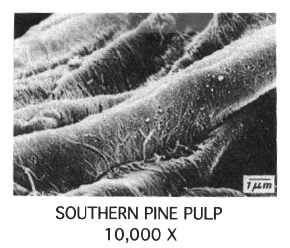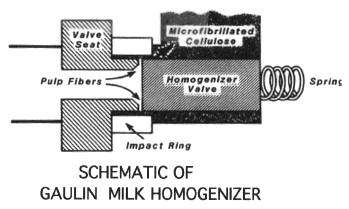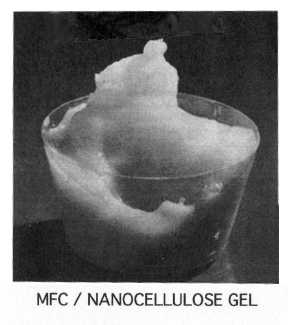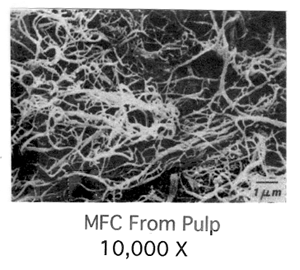 "Nano" is today's scientific buzzword and TAPPI, as the world's leading cellulose technical organization, now has established a Nanocellulose Division. So, what is nanocellulose, how is it made, what can it do, and why wasn't it used before?
"Nano" is today's scientific buzzword and TAPPI, as the world's leading cellulose technical organization, now has established a Nanocellulose Division. So, what is nanocellulose, how is it made, what can it do, and why wasn't it used before?  "Nano" is today's scientific buzzword and TAPPI, as the world's leading cellulose technical organization, now has established a Nanocellulose Division. So, what is nanocellulose, how is it made, what can it do, and why wasn't it used before?
"Nano" is today's scientific buzzword and TAPPI, as the world's leading cellulose technical organization, now has established a Nanocellulose Division. So, what is nanocellulose, how is it made, what can it do, and why wasn't it used before?
Since the Chinese discovered how to make paper in 150 B.C., cellulose scientists have realized that cellulose in trees and plants is comprised of millimeter-size fibers made up of consecutively smaller macrofibers and microfibers that contain microfibrils of nanometer (10-7- 10-9 meter) dimensions and form the basic building blocks of cellulose from all sources. Researchers were convinced that separated nanosize microfibrils would have immense surface areas and strong bonding, resulting in new products with vastly improved strength and performance characteristics. For example, imagine using a lightly beaten pulp to make a strong paper simply by adding small amounts of nanocellulose fibrils with their huge fiber bonding capability.
 Unfortunately, no one had ever made any nanocellulose from trees, none was for sale, and there were no literature references available describing how to make it. So for more than 2,000 years, nanocellulose was just a concept for scientific theoretical discussion—a sort of "holy grail" for cellulose chemists. In fact, no one had any idea of what nanocellulose from pulp should look like even if they found it.
Unfortunately, no one had ever made any nanocellulose from trees, none was for sale, and there were no literature references available describing how to make it. So for more than 2,000 years, nanocellulose was just a concept for scientific theoretical discussion—a sort of "holy grail" for cellulose chemists. In fact, no one had any idea of what nanocellulose from pulp should look like even if they found it.
In 1977 a research manager at the ITT Rayonier Eastern Research Division (ERD) Lab in Whippany, N.J., USA, who had used a Gaulin-type Milk Homogenizer to make edible breakfast sausage casings from cowhides, decided to run a 3% slurry of chopped pulp fibers through a high-pressure Manton Gaulin Milk Homogenizer. As the slurry reached 80°C at 8,000 psi, the fibers started to undergo a total phase change and turned into a translucent, firm "gel" that they called microfibrillated cellulose (MFC). Evidently, at the high temperature the high forces (pressure/cavitation/shear/impact) of the homogenizer acting in tandem or sequentially had broken down the cell walls of the microfibers and liberated the desired nanofibrils. More detailed info is available on Wikipedia (Nanocellulose/Cellulose/Biosynthesis).
 Definitive studies subsequently established that this stiff gel Rayonier was calling microfibrillated cellulose was, indeed, the long sort-after nanocellulose, and it had been isolated by a simple method with little (10% - 15%) DP (degree of polymerization) loss. The Rayonier research efforts were presented in two papers at the Ninth International Cellulose Conference at Syracuse University (1981). In 1982 – 1983, world economics forced ITT to shutdown both Rayonier labs and curtail further efforts in this area, but by then 11 patents had issued covering the preparation and uses of MFC.
Definitive studies subsequently established that this stiff gel Rayonier was calling microfibrillated cellulose was, indeed, the long sort-after nanocellulose, and it had been isolated by a simple method with little (10% - 15%) DP (degree of polymerization) loss. The Rayonier research efforts were presented in two papers at the Ninth International Cellulose Conference at Syracuse University (1981). In 1982 – 1983, world economics forced ITT to shutdown both Rayonier labs and curtail further efforts in this area, but by then 11 patents had issued covering the preparation and uses of MFC.
While Rayonier gave its pulp customers free license to all of these patents, there can be little doubt that the Rayonier MFC discovery was the birth of a totally new branch of cellulose technology, i.e. nanotechnology. For the next 30 years, all nanotechnology starting gels and developments that involved using the MFC high-pressure homogenizer procedure at some stage benefited from this discovery. Acid hydrolysis of nanocellulose produces nanocrystalline cellulose (NCC) rods that are capable of making products with unique properties and are currently under close scrutiny.
Many companies became active in the field and the three patents and two papers published by the Rayonier group in 1983 grew to 825 by 2007 and is much larger today. Various organizations used oxidized, derivatized, hydrolyzed, pre-swollen, enzyme-treated, and otherwise modified pulps as feed stocks with specially designed 30,000 – 45,000 psi homogenizers to lower energy requirements and vary nanoparticle-size distributions, which has simultaneously morphed MFC into NFC. These efforts have reportedly resulted in commercial MFC based scale-ups by Innventia (Sweden), Daicel (Japan),UPM Kymmene and VTT (Finland), Borregaard (Norway), and Rettenmaier (Germany), and should be applauded.
 Nanocellulose gel should have surface areas much greater than those currently reported, and this needs to be resolved since it relates directly to the thickening, absorption, and flow properties of many materials or composites. Nanocellulose gels, and modifications thereof, are currently being developed or commercially used for:
Nanocellulose gel should have surface areas much greater than those currently reported, and this needs to be resolved since it relates directly to the thickening, absorption, and flow properties of many materials or composites. Nanocellulose gels, and modifications thereof, are currently being developed or commercially used for:
As TAPPI's new Nanocellulose Division continues to mature, history will judge whether the Rayonier group in 1977 found the "cellulose holy grail" or, rather, somehow opened Pandora's Box.
(*) Dr. Turbak has served as national chairman of the Cellulose Division and of the Division Officers Group of the American Chemical Society, and as chairman of the High Purity Pulps Division of TAPPI. He was research director of the TeePak Division of Continental Can Co. and manager of basic research at Rayonier. He was professor and director of the Georgia Tech School of Polymer and Textile Engineering .Dr .Turbak has published many technical papers, consulted and lectured internationally, and holds more than 500 patents worldwide.
References
Patents
Turbak, A.F.; Snyder, F., and Sandberg, K.R. U.S. Patents 4,341,807; 4,452,721; 4,464,287; 4,483,743; 4,5 00,546; 4,374,702; 4,378,381; 4,487,634. Herrick, F.W. U.S. Patent 4,481,076; 4,481,077.
TAPPI
http://www.tappi.org/